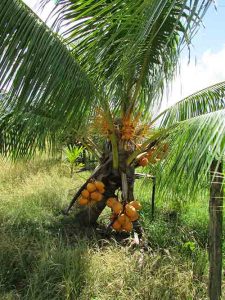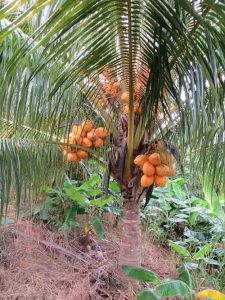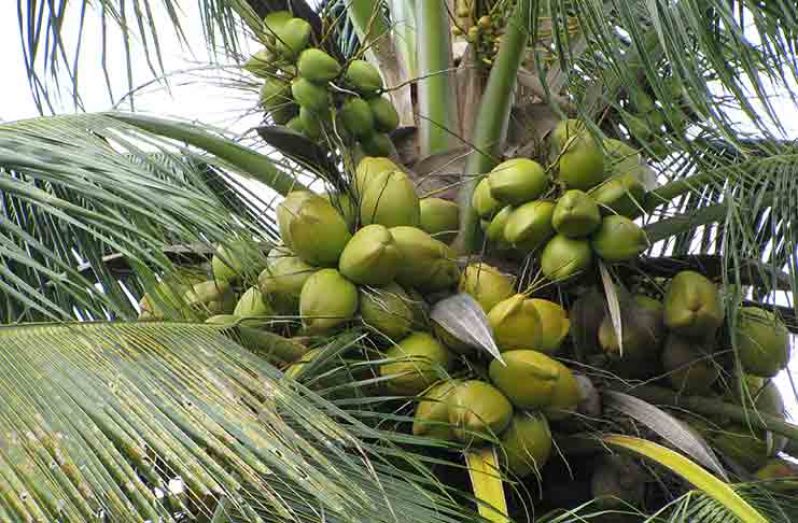The resuscitation of the coconut industry is a priority of the National Agricultural Research and Extension Institute (NAREI). Between October 27 and 30, 2016 Guyana held its first Coconut Festival that brought together stakeholders from across the country, Region and further afield.
The festival allowed the dissemination of information and provided a forum for farmers and processors to express concerns and share success stories about the emerging coconut industry. As such, starting from today NAREI will be sharing pertinent information about the coconut industry with readers.

This week’s feature seeks to educate readers about the different varieties of coconuts available in Guyana.
Anyone traversing the coastland of Guyana from Crabwood Creek to the Pomeroon, or on a visit to Essequibo Islands, would notice that the coconut palm is the most identifiable tree. There are palms in homesteads, pure coconut plantations as well as coconut intercropped with cash crops. It is estimated that there are 28,000 acres under coconut cultivation with an average annual yield of 92 million nuts.
A casual glance would indicate that there are many types of coconuts grown in Guyana. There are tall and short trees as well as those of intermediate sizes. Further, the nuts have distinct colours. In essence, there is a wide range (diversity) of coconut palms in Guyana. This diversity has been in existence for at least 100 years.
Commercial holdings of coconut are mainly planted with two types of the Tall variety and two types of the Dwarf variety. The Tall types are the predominant source of copra and oil while the Dwarf variety is specially grown for their sweet water. One variant of intermediate height, known as ‘Bastard Nut’, is grown in the Pomeroon River area and is cultivated for both copra production and for its sweet water, although its copra yield is inferior to the Tall types.
Tall types
The most common Tall types existing in the country are the Jamaica Tall and the Panama Tall, each consisting of two basic colour forms: Green and bronze. The Jamaica Tall bears long, angular nuts with distinct ridges and a thick mesocarp. De-husked, its nuts are also angular and pointed at the end. On the other hand, the fruits of the Panama Tall are much more spherical with thinner mesocarp. These two types may be considered the ‘original’ Tall types in Guyana.

Another variant of the Tall type found on the Coastal Corentyne (No. 60 Village), is a type with spherical, medium-sized nuts but with a pronounced dark pink mesocarp. Several variations in epicarp colour forms have also been observed. Generally, commercial stands could not be classified on this criterion alone. Farmers, however, could distinguish between the two Tall types known as Clara Nut and Cocrit Nut. Clara Nut is similar in character to the Panama Tall. Cocrit Nut, on the other hand, seems to combine the nut characteristics of the Jamaican Tall and the Panama Tall.
The Cocrit Nut is regarded as a ‘nut number’ type rather than a ‘nut size’ type. Fruits of the Cocrit Nut are more spherical than oblong, with a thin mesocarp and thick kernel. Nut size ranges from small to large, with trees of larger nuts being less prolific. Commercial copra producers prefer the ‘5-year’ (five years to begin production) nuts with an intermediate nut size, high yield and precocity.
The Clara Nut is a ‘nut size’ type. Husked nuts are large and spherical, with a high water capacity but thin kernel. The coconut water of this type is described as sweet and is favoured over all the other types grown for their coconut water. The hectarage devoted to Clara Nut, however, is minuscule compared to those variants preferred for copra.
A preponderance of Tall types can generally be found in all commercial
holdings. However, in the Pomeroon River area, there is a higher frequency of Dwarf types in commercial holdings.
Dwarf types

Commercial Dwarf types are mainly of the green and yellow ‘3-year’ (three years to begin production) variants. Manthriratoa (1980) described the Green Dwarf as being similar to the Brazilian Green Dwarf in growth habit, number of nut per bunch and size of nuts. The Yellow Dwarf, however, is different from the Malaysian Yellow Dwarf, in having a larger nut size and a less intense yellow colour in petioles and epicarps of the nuts. A third Dwarf type variant is the Red Dwarf (Orange Dwarf), restricted mainly to the Pomeroon River area.
Another variant, the Bronze Dwarf (so-called because of its bronze epicarp), is a relatively new find of about four years ago. The Bronze Dwarf was reportedly introduced from Surinam. Currently, there are only a few homesteads with this variety, but the current demand suggests it has the potential to spread rapidly to commercial holdings.
Bastard nut
Bastard Nut is predominately recognized in the Pomeroon River area.
The origin of this variant is attributed to natural cross pollination between Dwarf and Tall types, being an apparent Dwarf x Tall hybrid. Bastard Nuts show marked hybrid vigour in trunk and leaf size, number of bunches produced per year and number of nuts per bunch.(Contributed by Dr. Oudho Homenauth, Chief Executive Officer of NAREI)



.jpg)










